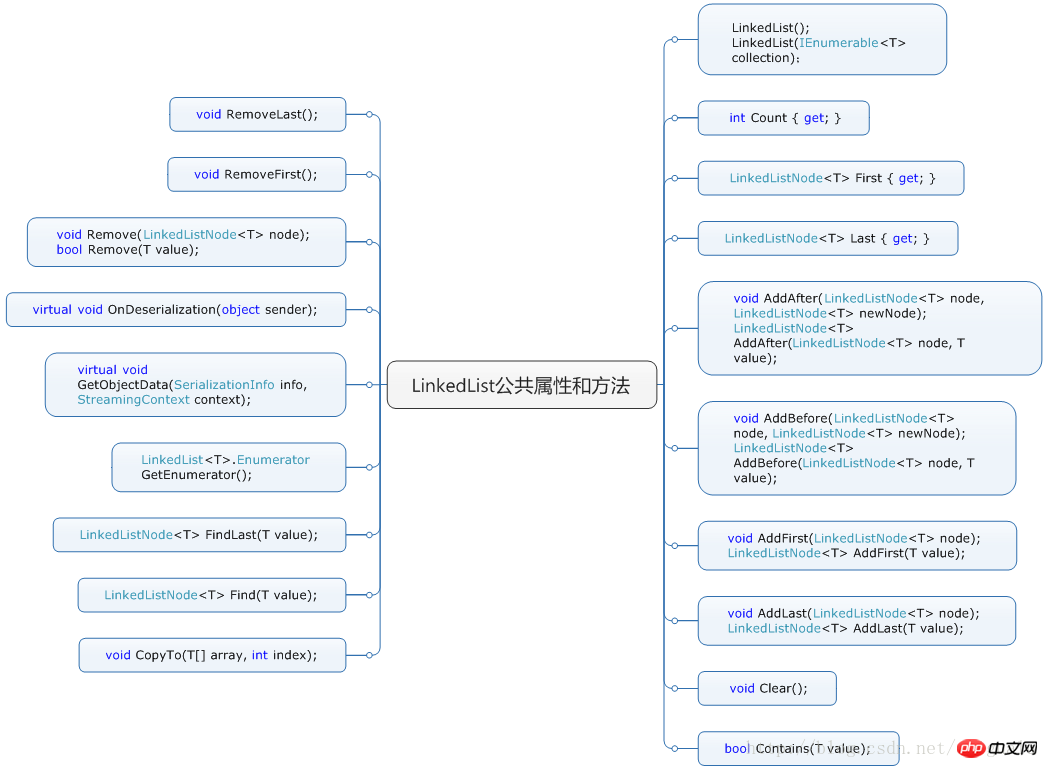.net框架中的linklist,实现的是双向链表,总结下它的实现源码。
先看下LinkedList提供的公有属性和方法的导图:

1 LinkedList实现的接口:
public class LinkedList<T> : ICollection<T>, ICollection, IReadOnlyCollection<T>, ISerializable, IDeserializationCallback
2 LinkedList的全局变量包括,
head是封装的类内头节点;
// This LinkedList is a doubly-Linked circular list.
internal LinkedListNode<T> head;
internal int count;
internal int version;
private object _syncRoot;
//A temporary variable which we need during deserialization.
private SerializationInfo _siInfo;
// names for serialization
private const string VersionName = "Version";
private const string CountName = "Count";
private const string ValuesName = "Data";封装的每个节点的数据结构为:
public sealed class LinkedListNode<T>
{ public LinkedListNode(T value);
//获取LinkedListNode所属的LinkedList
public LinkedList<T> List { get; }
public LinkedListNode<T> Next { get; }
public LinkedListNode<T> Previous { get; }
//获取节点中包含的值。
public T Value { get; set; }
}3 构造函数:
public LinkedList() //默认的构造函数
{
} //带有参数的
public LinkedList(IEnumerable<T> collection)
{ if (collection == null)
{ throw new ArgumentNullException(nameof(collection));
} foreach (T item in collection)
{
AddLast(item);
}
}在构造IEnumerable类型的collection时,用到了AddLast(T)方法,它还有一个重载,工作细节如下:
public LinkedListNode<T> AddLast(T value)
{
LinkedListNode<T> result = new LinkedListNode<T>(this, value);
if (head == null)
{
InternalInsertNodeToEmptyList(result);
} else
{
InternalInsertNodeBefore(head, result);
} return result;
}
public void AddLast(LinkedListNode<T> node)
{
ValidateNewNode(node);
if (head == null)
{
InternalInsertNodeToEmptyList(node);
} else
{
InternalInsertNodeBefore(head, node);
}
node.list = this; //结合LinkedListNode看
}以上2个方法,语义是插入某个节点,
分插入新节点到空list中,InternalInsertNodeToEmptyList
插入新节点到不为空的list中,InternalInsertNodeBefore,并且给出在哪个节点前插入newNode,还判断了新插入的节点是不是一个有效的新节点。
internal void ValidateNewNode(LinkedListNode<T> node)
{ if (node == null)
{ throw new ArgumentNullException(nameof(node));
} if (node.list != null)
{ throw new InvalidOperationException(SR.LinkedListNodeIsAttached);
}
}同时,还给出判断一个节点是不是有效节点:
internal void ValidateNode(LinkedListNode<T> node)
{ if (node == null)
{ throw new ArgumentNullException(nameof(node));
} if (node.list != this)
{ throw new InvalidOperationException(SR.ExternalLinkedListNode);
}
}这是双向链表比较重要的内部方法,
InternalInsertNodeToEmptyList的实现细节:
private void InternalInsertNodeToEmptyList(LinkedListNode<T> newNode)
{
Debug.Assert(head == null && count == 0, "LinkedList must be empty when this method is called!");
newNode.next = newNode;
newNode.prev = newNode;
head = newNode;
version++;
count++;
}InternalInsertNodeBefore的实现细节:
private void InternalInsertNodeBefore(LinkedListNode<T> node, LinkedListNode<T> newNode)
{
newNode.next = node;
newNode.prev = node.prev;
node.prev.next = newNode;
node.prev = newNode;
version++;
count++;
}4 链表自然离不开插入某个节点的公有方法,
public LinkedListNode<T> AddAfter(LinkedListNode<T> node, T value)
{
ValidateNode(node);
LinkedListNode<T> result = new LinkedListNode<T>(node.list, value);
InternalInsertNodeBefore(node.next, result); return result;
} public void AddAfter(LinkedListNode<T> node, LinkedListNode<T> newNode)
{
ValidateNode(node);
ValidateNewNode(newNode);
InternalInsertNodeBefore(node.next, newNode);
newNode.list = this;
} public LinkedListNode<T> AddBefore(LinkedListNode<T> node, T value)
{
ValidateNode(node);
LinkedListNode<T> result = new LinkedListNode<T>(node.list, value);
InternalInsertNodeBefore(node, result); if (node == head)
{
head = result;
} return result;
} public void AddBefore(LinkedListNode<T> node, LinkedListNode<T> newNode)
{
ValidateNode(node);
ValidateNewNode(newNode);
InternalInsertNodeBefore(node, newNode);
newNode.list = this; if (node == head)
{
head = newNode;
}
} public LinkedListNode<T> AddFirst(T value)
{
LinkedListNode<T> result = new LinkedListNode<T>(this, value);
if (head == null)
{
InternalInsertNodeToEmptyList(result);
} else
{
InternalInsertNodeBefore(head, result);
head = result;
} return result;
} public void AddFirst(LinkedListNode<T> node)
{
ValidateNewNode(node); if (head == null)
{
InternalInsertNodeToEmptyList(node);
} else
{
InternalInsertNodeBefore(head, node);
head = node;
}
node.list = this;
} public LinkedListNode<T> AddLast(T value)
{
LinkedListNode<T> result = new LinkedListNode<T>(this, value);
if (head == null)
{
InternalInsertNodeToEmptyList(result);
} else
{
InternalInsertNodeBefore(head, result);
} return result;
} public void AddLast(LinkedListNode<T> node)
{
ValidateNewNode(node); if (head == null)
{
InternalInsertNodeToEmptyList(node);
} else
{
InternalInsertNodeBefore(head, node);
}
node.list = this;
}5 再看下,清除链表所有节点,此处是设置所有节点不在指向内存堆,然后等GC回收,
public void Clear()
{
LinkedListNode<T> current = head;
while (current != null)
{
LinkedListNode<T> temp = current;
current = current.Next;
// use Next the instead of "next", otherwise it will loop forever
temp.Invalidate();
}
head = null;
count = 0;
version++;
}6 与只相对应的是移除某个节点的一些列接口,与添加类似,不再赘述,
Clear里面调用了Invalidate(),实现很简单:
internal void Invalidate()
{
list = null;
next = null;
prev = null;
}7 判断某个节点值为value的存在性,里面调用Find方法,
public bool Contains(T value)
{ return Find(value) != null;
}Find方法实现细节,类似的API还有FindLast,因为是双向链表,所以从尾部开始遍历链表即可,
public LinkedListNode<T> Find(T value)
{
LinkedListNode<T> node = head;
//调用默认相等比较器
EqualityComparer<T> c = EqualityComparer<T>.Default;
if (node != null)//链表为null
{
if (value != null)
{
do
{
if (c.Equals(node.item, value)) //Equals:某个节点node的item与value相等
{
return node;
}
node = node.next;
} while (node != head);
}
else
{
do
{
if (node.item == null)
{
return node;
}
node = node.next;
} while (node != head);
}
} return null; //链表为null,直接返回null
}8 再看一个复制数据到数组的实现:
public void CopyTo(T[] array, int index)
{
if (array == null)
{
throw new ArgumentNullException(nameof(array));
}
if (index < 0)
{
throw new ArgumentOutOfRangeException(nameof(index), index, SR.ArgumentOutOfRange_NeedNonNegNum);
}
if (index > array.Length)
{
throw new ArgumentOutOfRangeException(nameof(index), index, SR.ArgumentOutOfRange_BiggerThanCollection);
}
if (array.Length - index < Count)
{
throw new ArgumentException(SR.Arg_InsufficientSpace);
}
LinkedListNode<T> node = head;
if (node != null)
{
do
{
array[index++] = node.item;
node = node.next;
} while (node != head); //双向链表,再次遍历到头结点时
}
}以上就是.NET框架-双向链表(LinkedList)代码分析(图)的详细内容,更多请关注php中文网其它相关文章!

每个人都需要一台速度更快、更稳定的 PC。随着时间的推移,垃圾文件、旧注册表数据和不必要的后台进程会占用资源并降低性能。幸运的是,许多工具可以让 Windows 保持平稳运行。

Copyright 2014-2025 https://www.php.cn/ All Rights Reserved | php.cn | 湘ICP备2023035733号